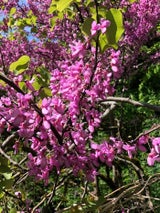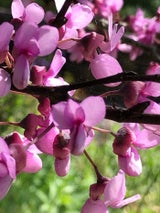- In the Garden
- >
- Gardens
- >
- Gardens I-P
- >
- Mediterranean Garden
- >
- Cercis siliquastrum
Cercis siliquastrum
Common names: Judas tree, Love tree, Mediterranean Redbud
Cercis siliquastrum, an often multi-stemmed deciduous tree belonging to the Pea family (Fabaceae), is native to the woodlands of southern Europe and western Asia. In Israel this tree has protected status. 'Kelil hahoresh' is its Hebrew name.
C. siliquastrum is a small tree which can reach about eight metres (26 feet) in height at maturity. Its deep pink flowers, which are produced on the previous year's growth, are similar in shape to those in the Pea family. The flowers bloom at about the same time as the leaves appear. C. siliquastrum is a cauliferous plant. The flowers bloom right on the bark of the branches and even on the trunk in clusters of three to six. These flowers are followed by long, flat, greenish brown seed pods, each about ten centimetres (four inches) long, that hang vertically. Roundish, heart-shaped, bronze-green leaves emerge in spring, turning green in summer, and changing to yellow in fall before shedding.
C. siliquastrum is a sun-loving tree. It grows best in a sheltered area. It is not fussy about soil as long as there is good drainage. The flowers of the Judas tree are rich in nectar and pollen, and are loved by bees and other pollinators. By the way, C. siliquastrum flowers are edible and have a sweet, tart taste. They are said to be good tossed in a salad. The seeds of C. siliquastrum are also edible and enjoyed by birds.
C. siliquastrum was first described by Swedish botanist Carolus Linnaeus in 1753. The genus name is derived from the Greek word 'kerkis' meaning 'shuttle'. The long, flat seed pods are thought to resemble a weaver's shuttle. The specific epithet is from the Latin word 'siliqua' meaning pod. There are two possibilities for the common name. First, the Judas tree was thought to be the tree from which Judas Iscariot hanged himself. There is a legend that after he hanged himself, the flowers which were originally white turned pink in shame. The second idea is that the tree is named after Judea, now called Israel, where the tree can be found.
There are several specimens of Cercis siliquastrum at VanDusen. The photos are of the tree in Bed 58B of the Mediterranean Garden. It was planted there in 1995.
Text and photos by Kumi Sutcliffe








